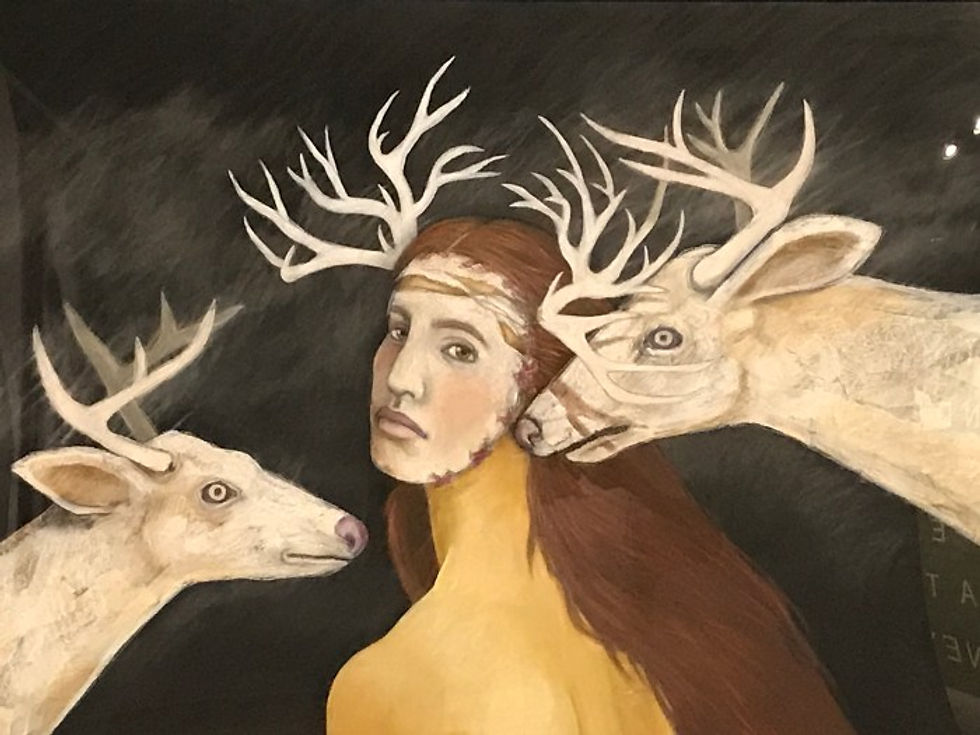
Judith Hernandez in One Path, Two Journeys at Millard Sheets Art Center. Photo Credit: Mario Vasquez.
Judithe Hernandez and Patssi Valdez: One Path Two Journeys
through January 28th Millard Sheets Art Center, Pomona in participation with Pacific Standard Time: La/LA
By Mario Vasquez What happens when two women artists, whose artistic practice involved political and social activism, begin painting? Do they abandon the activism? Or, do they express it in new ways that define a new paradigm in their work? These are the questions that are asked in Judithe Hernandez and Patssi Valdez: One Path Two Journeys, currently at the Millard Sheets Art Center through January 28 and part of Pacific Standard Time: LA/LA. The two Chicana painters whose work changed and transformed after the 1970s, Judithe Hernández (b 1948) joined Los Four and Patssi Valdez (b 1951) co-founded Asco, both were active from late 1960s to the early 1980s. Hernandez painted murals addressing immigrant rights and the plight of agricultural workers. Valdez’s work at the same time involved performance, photography, and video, which explored Chicano/Chicana identity and politics, the role of women and gender, and the civil rights of Chicanos living and working in East Los Angeles and elsewhere.
While the exhibition examines the early activity with photographs and video, the exhibition’s main focus is on what happened to their artistic practice after the 1970s when both Valdez and Hernandez make a major shift toward painting. Their painting practices are similar to their approaches, yet are distinct in their subject matter and emphasis on aspects of the feminine. When looking at the paintings of Hernandez and Valdez, each reassert a Surrealism that was prevalent in the mid-20th century. Their works recall Leonora Carrington, Remedios Varo, and Frida Kahlo and other Surrealists active in Mexico around the time of the Second World War. Both painters create a dichotomy where Hernandez’s paintings reflect a concern for nature and exterior states of emotion, and Valdez’s works are interior and domestic.
Valdez’s paintings portray interiors and the magic that occurs within the settings of rooms and the objects around. Very few of Valdez’ paintings have people within the picture. However, the objects that populate the rooms are imbedded with magic and spirits, and take on characteristics of animated beings. With vibrant colors, works like Somber Clouds (2015) and Broken (1992) tables and objects are shown floating within the rooms of each painting. Valdez likes to place the picture plane at an angle to create an almost dream-like state. Valdez’ paintings are enigmatic, because the scenes are magical and commonplace. The table, the tea cups with saucers, the kettle, etc. all play a role in the magic that Valdez creates. The scenes are places where both the feminine and nature come to meet and converse. Recent new works by Valdez such as The Aztec Queen (2016) and Pan Mexicano (2017) directly explore Chicano history, feminine and the idea of the goddess; the strong feminine women who is unafraid and assertive.

Patssi Valdez in One path, Two Journeys at Millard Sheets Art Center. Photo Credit: Mario Vasquez.
The art of Judithe Hernandez also emphasizes the strong and assertive woman. In contrast to Valdez’s work, Hernandez’s paintings are about the exterior. Hernandez explores the body, nature as it relates to the animal kingdom, the feminine, and the struggle between life and death, all of which occurs within the context of the animal and plant kingdoms. Paintings such as L’Epee de Saint Jeanne (The Sword of St. Joan) (2013), The Birth of Eve (2010) and The Purification (2013) portray women as embracing the natural world and becoming in tune with the uncorrupted. In other works, Hernandez is expressing the pain and corruption of the outside world as in the paintings The Weight of Silence, or Aetatis Suae 3 (2013). There are artworks that portray strong assertive women such The Virgin of Darkness (2010) or La Luchadora (2008). Death and the feminine are also interacting with each other as if the presence of death is a natural and constant in life. There is a fatalism in her paintings that Hernandez is comfortable with. Her work also delves into magical realism, where the mystical and spiritual occurrences blend in with the every day.
It is the portrayal of the everyday that the title of the exhibition becomes clearer. Both Valdez and Hernandez pursue an exploration of magical realism and reassertion of surrealist themes and ideas. At the same time, there is a divergence that occurs with the subject matter. Valdez explores the magic that occurs within the interior of a living space where the objects and the environment are possessed with the enchanted. Hernandez is portraying the outside world where nature, magic, the feminine, and death interact with a confidence that asserts the strength and endurance of the indigenous woman. The question then arises is whether both Patssi Valdez and Judithe Hernandez are maintaining the Chicano activism that initially propelled their artistic careers. Valdez and Hernandez shifted their practice, as many of their contemporaries such as Magu, Carlos Almarez, Gronk, and Frank Romero, and began painting a personal style. It was once stated that being a Chicano is not just an identity, but also an ideology. It is about the embracing of the indigenous. In this respect, magic and shamanism is a part of this ideology. Valdez and Hernandez are thus painting the spiritual and magical that is as much a part of Latino and Chicano identity and ideology. Both assert the indigenous and the feminine in the context of the magical and the surreal.
Millard Sheets Art Center at The Fairplex 1101 W McKinley Ave. Pomona, CA 91768 millardsheetsartcenter.org
#losangeles #california #artinLA #art #painting #MillardSheetsArtCenter #losangelesart #contemporaryart #PatssiValdez #southerncalifornia #abstract #collage #feminist #artgallery #pomona #gallery #PacificStandardTIme #artandcake #artexhibition #femaleartists #mariovasquez #installation #ArtandCakeLA #fineart #artists #artist #PacificStandardTimeLALA #mixedmedia #arts #LAFlairplex #artreview #millardsheets #artmagazine #Onepathtwojourneys #ArtandCulture #exhibition #FAirplex #pstlala #JudithHernandez #exhibit #drawing






































